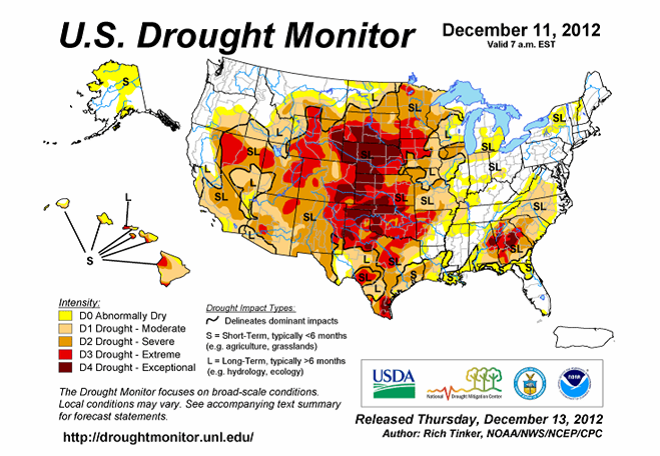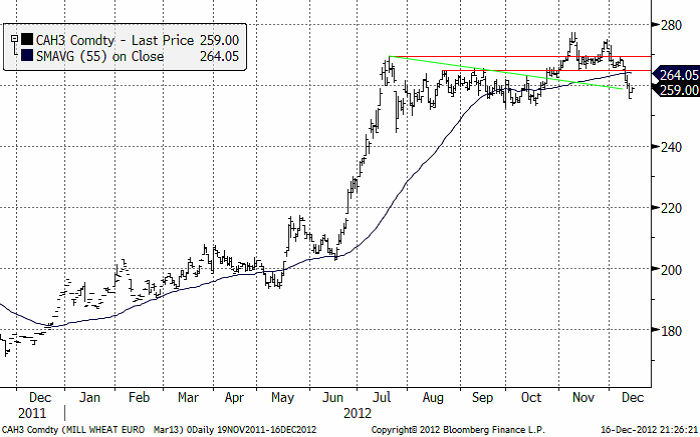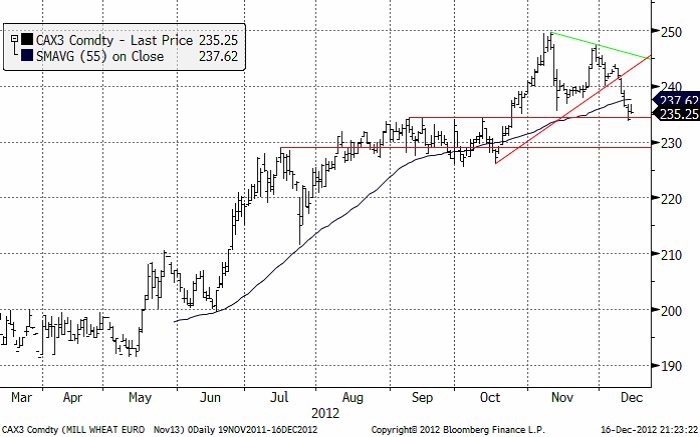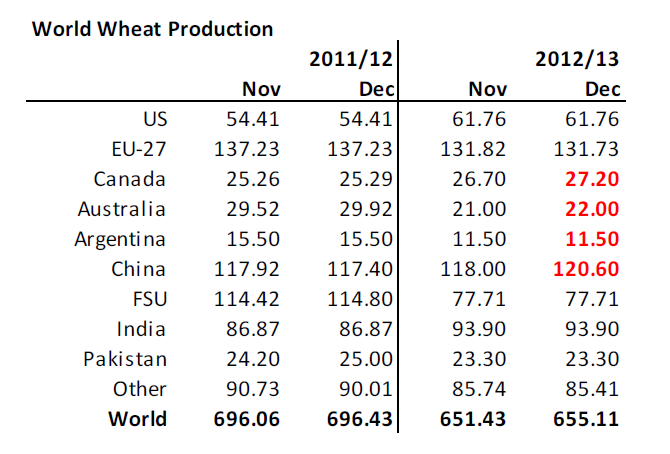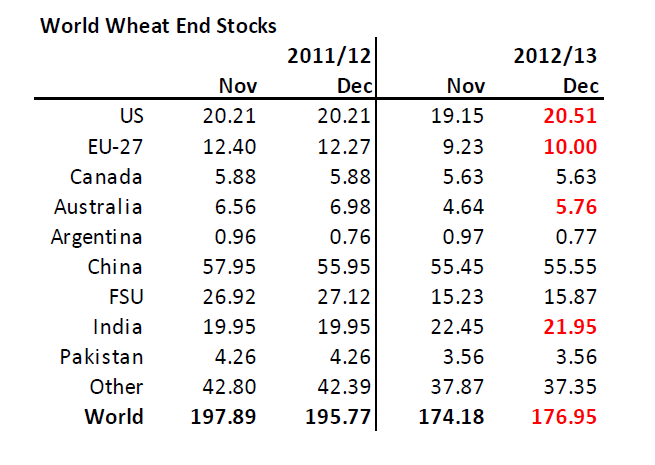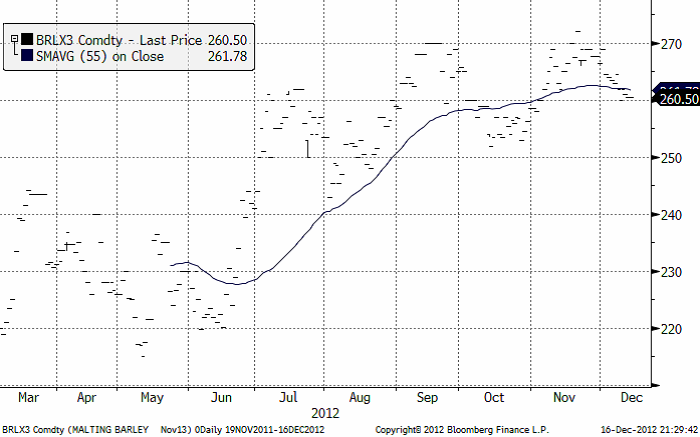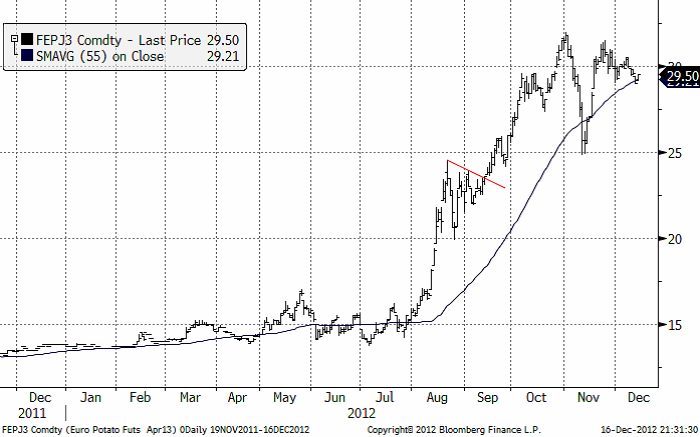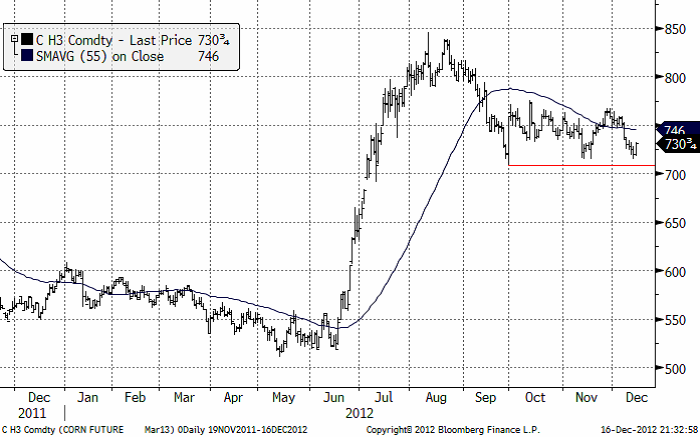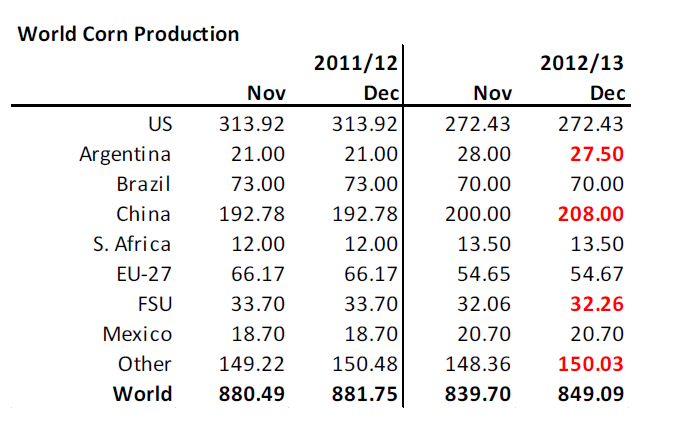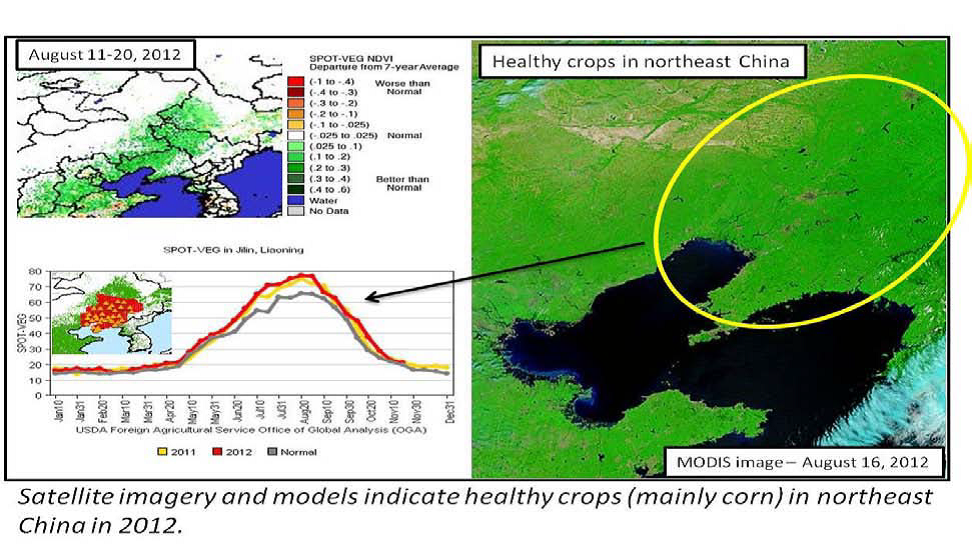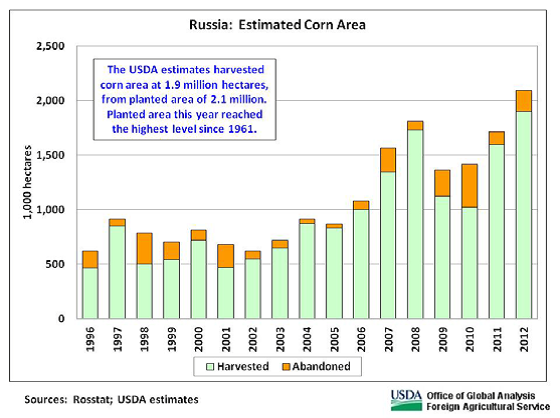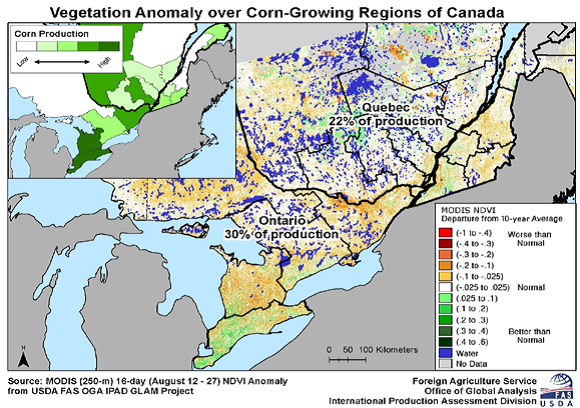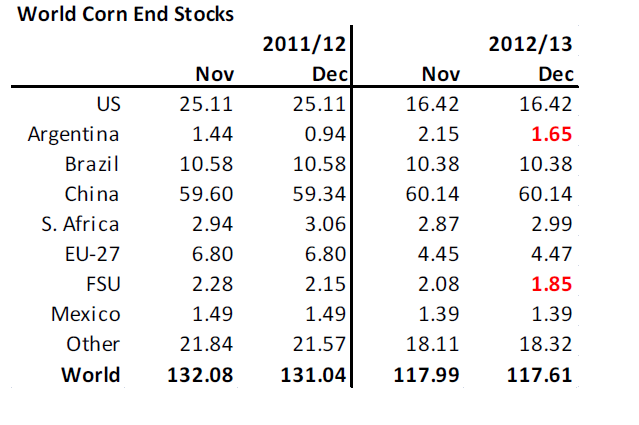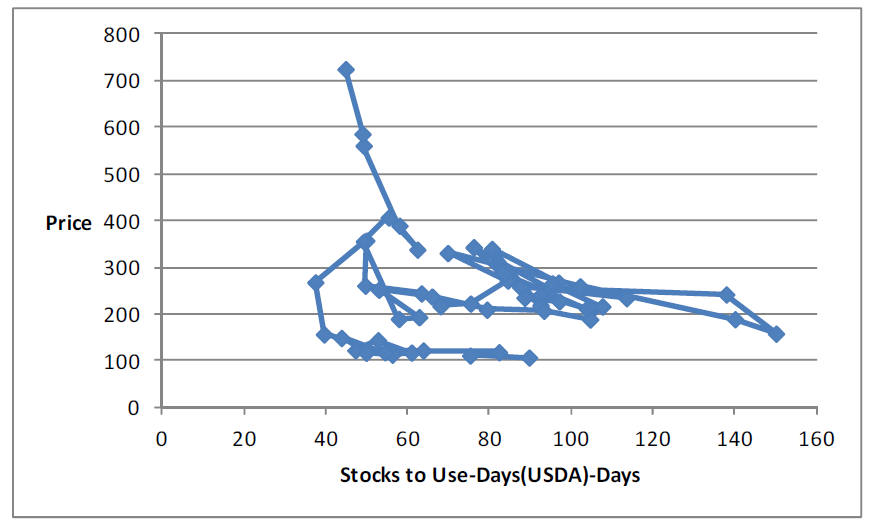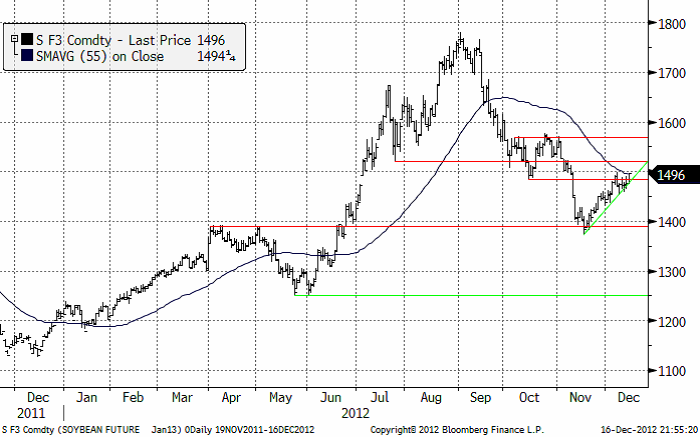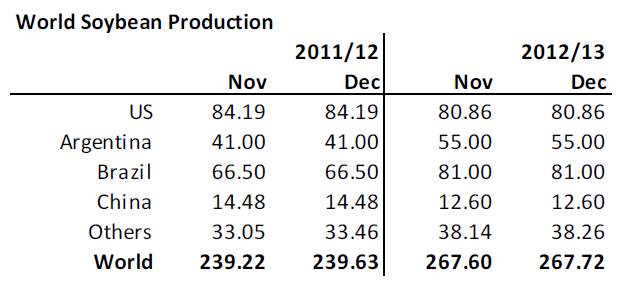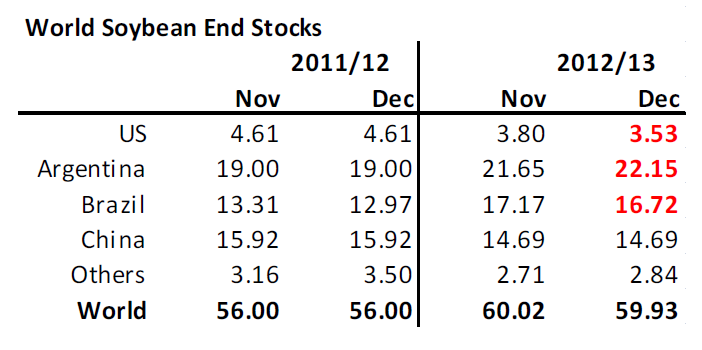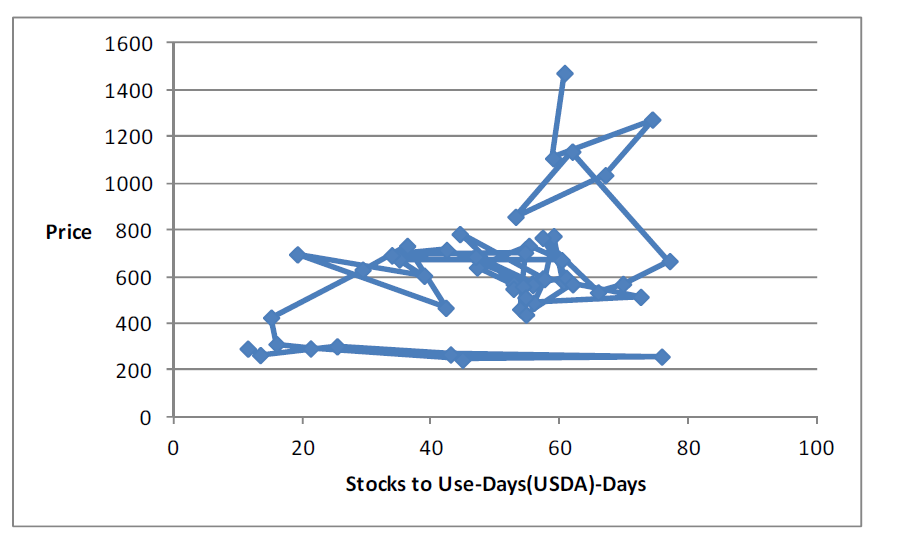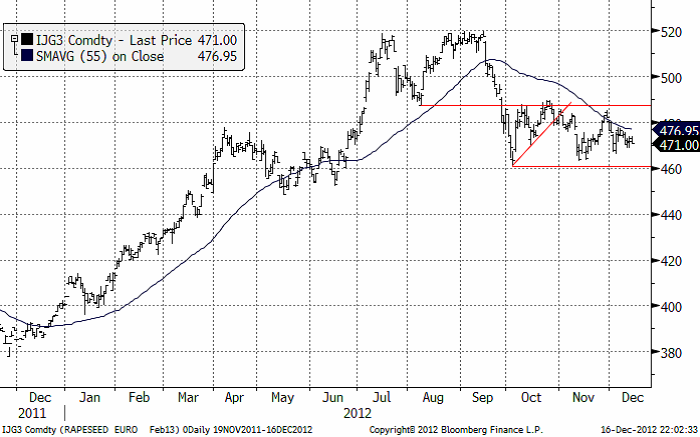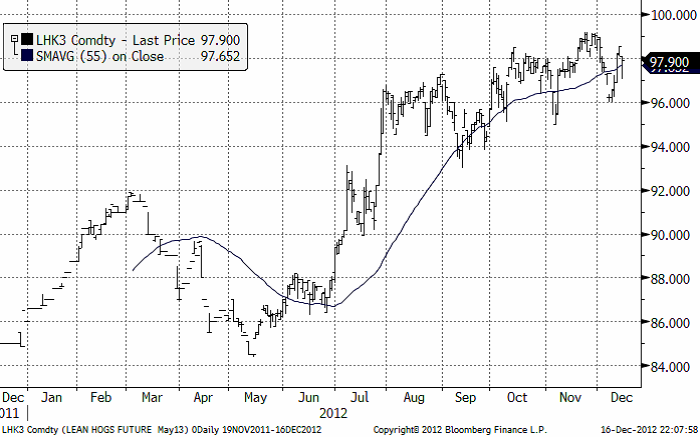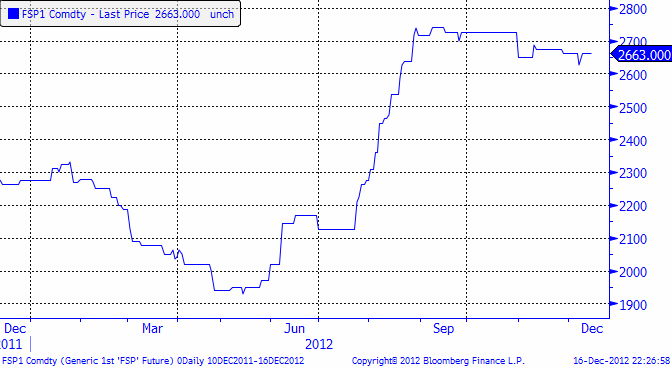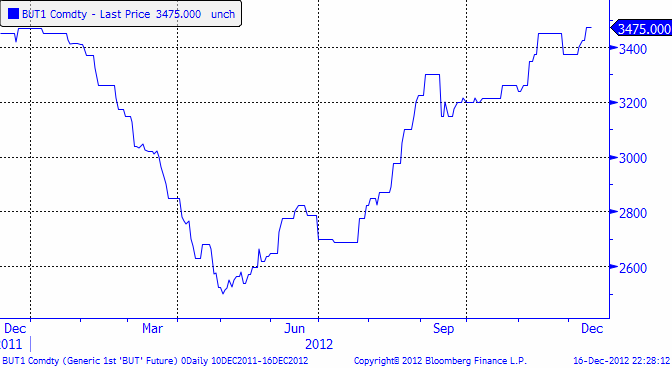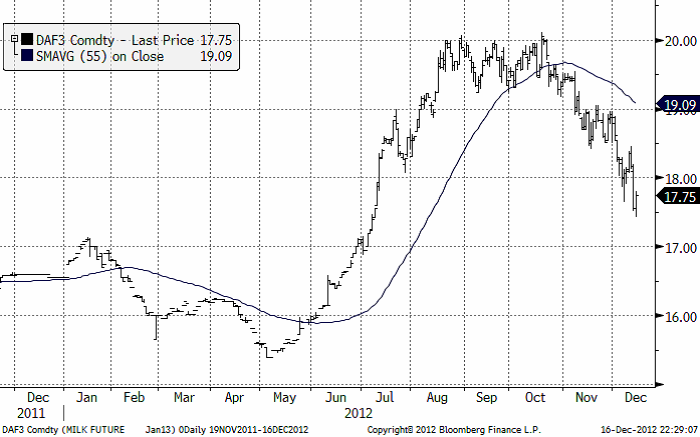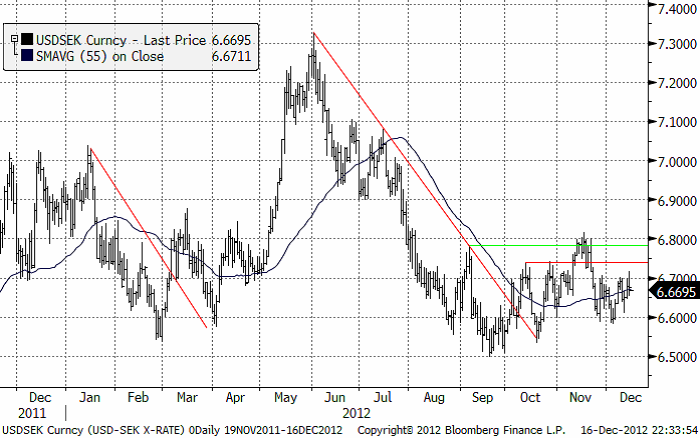Analys
SEB Jordbruksprodukter, 17 december 2012
 Vi byter rekommendation för vetepriset från ”köp” till ”sälj”. Visst finns chansen / eller risken, att det kommer ytterligare en prisuppgång, men den är i så fall sannolikt den sista innan priset vänder ner. Det kanske inte alls kommer någon prisuppgång, framåt februari, som en del talar om. Vi börjar tycka att det är dags att sluta hoppas på den sista uppgången, och istället positionera oss för den större prisnedgången.
Vi byter rekommendation för vetepriset från ”köp” till ”sälj”. Visst finns chansen / eller risken, att det kommer ytterligare en prisuppgång, men den är i så fall sannolikt den sista innan priset vänder ner. Det kanske inte alls kommer någon prisuppgång, framåt februari, som en del talar om. Vi börjar tycka att det är dags att sluta hoppas på den sista uppgången, och istället positionera oss för den större prisnedgången.
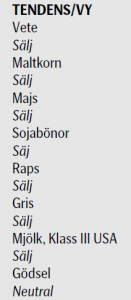 Vi ändrar också rekommendation på maltkornet från neutral till sälj och det betyder att vi har säljrekommendation för alla jordbruksprodukter. Majs ser för närvarande trendlöst ut, men sojabönorna som sakta rekylerat uppåt, ser redo att bryta nedåt ut. Efter den senaste WASDE-rapporten förefaller ”rätt pris” i förhållande till utgående lager, vara ca 200 cent / bushel lägre än dagens pris.
Vi ändrar också rekommendation på maltkornet från neutral till sälj och det betyder att vi har säljrekommendation för alla jordbruksprodukter. Majs ser för närvarande trendlöst ut, men sojabönorna som sakta rekylerat uppåt, ser redo att bryta nedåt ut. Efter den senaste WASDE-rapporten förefaller ”rätt pris” i förhållande till utgående lager, vara ca 200 cent / bushel lägre än dagens pris.
Odlingsväder
Det är fortsatt torrt mitt i USA, men det har regnat i södra USA. Europa är nu helt och hållet snötäckt där det ska vara det. Det är bara i södra Ryssland som det ännu inte finns snö.
Vete
Nedan ser vi mars (2013) kontraktet, där priset föll direkt när WASDE-rapporten blev känd. Priset har ännu inte fallit under oktober månads lägsta noteringar. Skulle priset göra det, får vi en bekräftelse på att en ny baisse-marknad för vete är inledd. Vi tror att det är en tidsfråga innan det sker.
Nedan ser vi kursdiagrammet för kommande skörd, november 2013. Priset bröt den uppåtgående stödlinjen vid strax över 240 euro per ton som en respons på WASDE-rapporten. Därefter har priset fallit ner till stödlinjen vid 235 euro. Där fanns köpare. Det är möjligt att det kommer en rekyl uppåt i veckan. Vi anser att den rekylen uppåt i så fall är ett säljtillfälle, och rekylen bör maximalt, enligt den tekniska analysen, gå upp mot 240 euro, men troligtvis inte över.
USDA’s uppjustering av utgående globala lager i decembers WASDE-rapport fick priset att falla både på Matif och i USA. Nedan ser vi produktionsestimaten i WASDE-rapporten:
Vi ser att USDA höjde skördeprognosen för 2012/13 med 4 mt. Uppjusteringarna gjordes för Kanada, Australien och Kina. Däremot gjorde man inte någon förändring för Argentina. USDA uppskattar Kinas vete produktion 2012/13 till 120.6 mt, vilket är en ökning med 2.6 mt från förra månaden. Den estimerade arealen på 24.14 miljoner hektar har justerats ned något medan estimerad avkastning justeras upp till rekordhöga 5.0 ton per hektar. Revideringarna bygger på de senaste officiella uppgifterna från Kinas National Bureau of Statistics. Enligt rapporter så visar de 11 största vete producerande provinserna högre avkastning 2012, vilket är det nionde året i rad med stabila eller stigande avkastningar. Gynnsamt väder under hela perioden, från sådd till skörd, har varit faktorn som bidragit till en rekordskörd av höstvete 2012.
Även Australiens produktion av vete 2012/13 justeras upp med 1 mt till 22 mt av USDA, medan arealen lämnas oförändrad.
USDA’s estimat för EU-27’s produktion av vete 2012/13 justeras ned marginellt från 131.82 till 131.73 mt. Revideringen beror på en nedjustering av produktionen i Frankrike. Nedan ser vi utgående lager, som väntas bli nästan 3 mt högre än i november månads WASDE-rapport. Till de viktigaste förändringarna hör att utgående lager väntas bli högre i de stora exportländerna USA och EU som helhet. Även i Australien väntas utgående lager bli högre. Detta tolkades av marknaden som negativt och fick priserna på fall. Detta sammanfaller med en förskjutning i sentimentet i marknaden. För många aktörer är frågan om huruvida det kommer (ännu) högre priser, eller om det är slut med haussen nu, mycket viktig och en källa till oro. Om dessa aktörer, stora spannmålshandlare och lantbrukare, börjar tro att det är slut på uppgången, finns sannolikt ett stort latent intresse från dem att sälja på dessa attraktiva priser, som det fortfarande är.
I diagrammet nedan ser vi priserna per stängning på WASDE-rapportdagen förra veckan och för tidigare års december-WASDE. Vi ser att priset ser högt ut, enligt den relation mellan lager och pris som har varit rådande de senaste åren. Priset på Chicagovete, som är det som visas i diagrammet, ser ut att ha ett mer ”rätt” pris, mellan 600 och 700 cent.
Sammanfattningsvis, det ser svagt ut tekniskt och priset ser högt ut i förhållande till väntade utgående lager. Därför byter vi från vår nu gamla köprekommendation från i somras och rekommenderar en såld position i vete. Möjligtvis kan en kortvarig rekyl uppåt komma med några euro per ton. Det är i så fall ett säljtillfälle.
Maltkorn
November 2013-kontraktet har fortsatt att falla i pris för andra veckan. Vi ser i diagrammet nedan att styrkan i marknaden successivt har avtagit sedan slutet av sommaren.
Potatis
Potatispriset för leverans i april har sjunkit något sedan förra veckan och handlas nu under 30 euro per dt. Även i potatismarknaden ser vi att styrkan i uppgången har avtagit de senaste månaderna.
Majs
Majspriset (mars 2013) föll mycket riktigt ner mot stödet, som ligger på 710 cent. I fredags hämtade sig priset och stängde nära dagshögsta. Det är svårt att säga om marknaden kommer att attrahera nya säljare i veckan som kommer, så att stödet testas igen, eller om det kommer en rekyl uppåt i veckan som kommer. I avsaknad av några större nyheter kanske marknaden fortsätter att röra sig ”sidledes” ett tag till.
USDA gjorde en ganska stor uppjustering av skörden 2012/13, som vi ser i nedanstående tabell. Möjligtvis sänkte man skörden för lite i Argentina, där det på grund av regnen är många som kommer att så sojabönor istället. De kan sås senare än majs. Annars skedde den stora uppjusteringen i Kina. Och det betyder att den nog inte är så säker. Man har tagit den officiella prognosen från Kina, rakt av.
Kinas majsproduktion 2012/13 uppskattas till rekordhöga 208 mt av USDA, en rejäl ökning jämfört med förra årets rekordskörd på 192.8 mt. Arealen för majs uppskattas till 34.9 miljoner hektar, en ökning med 1.4 miljoner från förra året. En stor del av ökningen i areal är bland annat på bekostnad av sojabönor, framförallt i Heilongjiang provinsen i nordöstra Kina, där lantbrukarnas intjäning på majs är betydligt högre än på sojabönor.
Avkastningen beräknas till rekordhöga 5.96 ton per hektar, och Kinas majs avkastning har haft en stigande trend under de senaste 10 åren och ökat med mer än 20 procent sedan 2003/2004. Riklig nederbörd har gynnat grödorna i de normalt torra regionerna i nordöstra och norra Kina, och omfattande bevattning har mildrat torkans effekter över den norra kinesiska slätten.
Även Rysslands produktion av majs 2012/13 estimeras till rekordhöga 8.5 mt av USDA, en ökning med 1 mt från förra månaden och upp 27 procent från förra årets rekordskörd på 6.7 mt. Avkastningen beräknas till 4.47 ton per hektar, vilket är 27 procent högre än det 5-åriga genomsnittet. En ökning av skördad areal är en bidragande faktor till den höga produktionen och beror på en kombination av faktorer, bland annat en ökad användning av majs som foder inom fjäderfäsektorn och ovanligt högt bortfall av 2012/13 års vintergrödor i södra Ryssland.
Canadas majs produktion 2012/13 justeras också upp till rekordhöga 13.1 mt av USDA, vilket är en ökning med nästan 1.5 mt från förra månaden. Arealen lämnas oförändrad på 1.42 miljoner hektar, vilket dock är en ökning med 16 procent från förra året, medan avkastningen på 9.20 ton per hektar är en minskning med 2.7 procent från förra året. Rekordhög skördad areal i både Ontario och Quebec, tillsammans med en högre avkastning i Quebec, har bidragit till rekord produktionen som en följd av gynnsamt varmt och torrt väder vid sådd.
Trots att man dragit till med 8 mt högre skörd i Kina, blir utgående lager oförändrade, som vi ser nedan.
Nedan ser vi utgående lager (prognosen) i förhållande till pris. Vi ser att majs aldrig varit så dyrt. Eftersom det inte finns några omkringliggande punkter (pris vs lager) att ta som referens, kan vi inte säga om priset är omotiverat högt eller inte. Bara att det högt.
Vi tror att priset borde komma ner, men det går inte att säga utifrån ovanstående relation om majs är ”felvärderat” idag, enligt förhållandet till utgående lager.
Sojabönor
Sojabönorna har fortsatt att handla högre med stödlinjen uppåt. Priset har kommit upp i motståndsnivåer. Det ”borde” vara slut på uppgången vid den här nivån. Vi rekommenderar därför sälj på sojabönor.
USDA lämnade produktions estimaten i princip oförändrade i förra veckans månatliga uppdatering av World Supply and Demand Estimates, WASDE.
Utgående lager justeras ned ytterst marginellt. Som vi ser är utgående lager i USA väldigt litet och ”borde” kanske ha sänkts mer, men det är ju näst intill omöjligt. Argentina justerades upp och Brasilien likaså.
Nedan ser vi var priset befinner sig i förhållande till utgående lager i termer av dagars konsumtion. Vi ser att priset ser kanske något högt ut i förhållande till relationen de senaste åren. Priset skulle kunna falla ner mot 1200 utan att det skulle vara ”fel” ur ett värderingsperspektiv, när man bara jämför med lager.
Till skillnad från majs, men i likhet med vete, ser priset på sojabönor högt ut i förhållande till väntade utgående lager. Även tekniskt ser det ut som om ett ”brott” nedåt är nära förestående. Vi rekommenderar en kort position i sojabönor.
Raps
Rapspriset (februari 2013) har fallit några euro sedan förra veckan. Det verkar som om rapspriset därmed tagit mer intryck av Matif-vetets fall, än sojabönornas uppgång. Som vi skrev ovan, är det inte uteslutet, utan ganska troligt, att det kommer en kortvarig rekyl uppåt i Matif-vetet, och om rapsen fortsätter att följa den marknaden, kan det komma en rekyl uppåt i majsen också. Sojabönorna tror vi bryter ner, kanske redan den här veckan, så mellan dessa krafter är det kanske ”sidledes” rörelse som blir följden för rapsen.
Gris
Grispriset (Maj 13) följer vi nu, när december 12-kontraktet förfaller. Det finns inte mycket mer att säga. Trenden uppåt är försvagad, liksom för alla jordbruksprodukter.
Mjölk
Priset på mjölkpulver på Eurexbörsen steg något sedan förra veckan.
Nedan ser vi priset på smör, som är lite starkare än marknaden för pulver och som fortsatt att stiga, nu till 3475 euro per ton.
Det börsbaserade priset i svenska kronor beräknas med formeln:
där
BUT = priset på smör i euro per ton
SMP = priset på skummjölkspulver i euro per ton
FX = växelkursen för EURSEK.
Nedan ser vi januari-kontraktet på amerikansk klass 3-mjölk, som föll ytterligare i veckan som gick. Det fanns ett stöd på 18 cent per pund, som marknaden föll rakt igenom. Nästa tekniska stödnivå finns på 17 cent. Priset stängde i fredags på 17.75 cent.
EURSEK
EURSEK har något oväntat brutit uppåt och noterat de högsta kurserna mot kronan sedan juni. Det finns emellertid starka motstånd vid dagens kursnivå, som gör att vi inte tror att priset går högre just nu. Trenden måste vi nog säga är uppåtriktad just nu.
USDSEK
Dollarna fortsätter att handlas ”sidledes”. 6.60 kr per dollar ser ut som ett stöd. Kursen har vänt upp från den nivån två gånger sedan månadsskiftet oktober/november. 6.70 ser likaledes ut som en motståndsnivå. Vid 6.80 ser vi ytterligare en motståndsnivå. Just nu ser det ut som om vi kan förvänta oss ännu mer ”sidledes” rörelse inom detta intervall.
[box]SEB Veckobrev Jordbruksprodukter är producerat av SEB Merchant Banking och publiceras i samarbete och med tillstånd på Råvarumarknaden.se[/box]
Disclaimer
The information in this document has been compiled by SEB Merchant Banking, a division within Skandinaviska Enskilda Banken AB (publ) (“SEB”).
Opinions contained in this report represent the bank’s present opinion only and are subject to change without notice. All information contained in this report has been compiled in good faith from sources believed to be reliable. However, no representation or warranty, expressed or implied, is made with respect to the completeness or accuracy of its contents and the information is not to be relied upon as authoritative. Anyone considering taking actions based upon the content of this document is urged to base his or her investment decisions upon such investigations as he or she deems necessary. This document is being provided as information only, and no specific actions are being solicited as a result of it; to the extent permitted by law, no liability whatsoever is accepted for any direct or consequential loss arising from use of this document or its contents.
About SEB
SEB is a public company incorporated in Stockholm, Sweden, with limited liability. It is a participant at major Nordic and other European Regulated Markets and Multilateral Trading Facilities (as well as some non-European equivalent markets) for trading in financial instruments, such as markets operated by NASDAQ OMX, NYSE Euronext, London Stock Exchange, Deutsche Börse, Swiss Exchanges, Turquoise and Chi-X. SEB is authorized and regulated by Finansinspektionen in Sweden; it is authorized and subject to limited regulation by the Financial Services Authority for the conduct of designated investment business in the UK, and is subject to the provisions of relevant regulators in all other jurisdictions where SEB conducts operations. SEB Merchant Banking. All rights reserved.
Analys
Brent crude set to dip its feet into the high $50ies/b this week

Parts of the Brent crude curve dipping into the high $50ies/b. Brent crude fell 2.3% over the week to Friday. It closed the week at $61.29/b, a slight gain on the day, but also traded to a low of $60.14/b that same day and just barely avoided trading into the $50ies/b. This morning it is risk-on in equities which seems to help industrial metals a little higher. But no such luck for oil. It is down 0.8% at $60.8/b. This week looks set for Brent crude to dip its feet in the $50ies/b. The Brent 3mth contract actually traded into the high $50ies/b on Friday.

The front-end backwardation has been on a weakening foot and is now about to fully disappear. The lowest point of the crude oil curve has also moved steadily lower and lower and its discount to the 5yr contract is now $6.8/b. A solid contango. The Brent 3mth contract did actually dip into the $50ies/b intraday on Friday when it traded to a low point of $59.93/b.
More weakness to come as lots of oil at sea comes to ports. Mid-East OPEC countries have boosted exports along with lower post summer consumption and higher production. The result is highly visibly in oil at sea which increased by 17 mb to 1,311 mb over the week to Sunday. Up 185 mb since mid-August. On its way to discharge at a port somewhere over the coming month or two.
Don’t forget that the oil market path ahead is all down to OPEC+. Remember that what is playing out in the oil market now is all by design by OPEC+. The group has decided that the unwind of the voluntary cuts is what it wants to do. In a combination of meeting demand from consumers as well as taking back market share. But we need to remember that how this plays out going forward is all at the mercy of what OPEC+ decides to do. It will halt the unwinding at some point. It will revert to cuts instead of unwind at some point.
A few months with Brent at $55/b and 40-50 US shale oil rigs kicked out may be what is needed. We think OPEC+ needs to see the exit of another 40-50 drilling rigs in the US shale oil patches to set US shale oil production on a path to of a 1 mb/d year on year decline Dec-25 to Dec-26. We are not there yet. But a 2-3 months period with Brent crude averaging $55/b would probably do it.
Oil on water increased 17 mb over the week to Sunday while oil in transit increased by 23 mb. So less oil was standing still. More was moving.

Crude oil floating storage (stationary more than 7 days). Down 11 mb over week to Sunday

The lowest point of the Brent crude oil curve versus the 5yr contract. Weakest so far this year.

Crude oil 1mth to 3mth time-spreads. Dubai held out strongly through summer, but then that center of strength fell apart in late September and has been leading weakness in crude curves lower since then.

Analys
Crude oil soon coming to a port near you

Rebounding along with most markets. But concerns over solidity of Gaza peace may also contribute. Brent crude fell 0.8% yesterday to $61.91/b and its lowest close since May this year. This morning it is bouncing up 0.9% to $62.5/b along with a softer USD amid positive sentiment with both equities and industrial metals moving higher. Concerns that the peace in Gaza may be less solid than what one might hope for also yields some support to Brent. Bets on tech stocks are rebounding, defying fears of trade war. Money moving back into markets. Gold continues upwards its strong trend and a softer dollar helps it higher today as well.

US crude & products probably rose 5.6 mb last week (API) versus a normal seasonal decline of 2.4 mb. The US API last night partial and thus indicative data for US oil inventories. Their data indicates that US crude stocks rose 7.4 mb last week, gasoline stocks rose 3.0 mb while Distillate stocks fell 4.8 mb. Altogether an increase in commercial crude and product stocks of 5.6 mb. Commercial US crude and product stocks normally decline by 2.4 mb this time of year. So seasonally adjusted the US inventories rose 8 mb last week according to the indicative numbers by the API. That is a lot. Also, the counter seasonal trend of rising stocks versus normally declining stocks this time of year looks on a solid pace of continuation. If the API is correct then total US crude and product stocks would stand 41 mb higher than one year ago and 6 mb higher than the 2015-19 average. And if we combine this with our knowledge of a sharp increase in production and exports by OPEC(+) and a large increase in oil at sea, then the current trend in US oil inventories looks set to continue. So higher stocks and lower crude oil prices until OPEC(+) switch to cuts. Actual US oil inventory data today at 18:00 CET.
US commercial crude and product stocks rising to 1293 mb in week 41 if last nights indicative numbers from API are correct.

Crude oil soon coming to a port near you. OPEC has lifted production sharply higher this autumn. At the same time demand for oil in the Middle-East has fallen as we have moved out of summer heat and crude oil burn for power for air-conditioning. The Middle-East oil producers have thus been able to lift exports higher on both accounts. Crude oil and condensates on water has shot up by 177 mb since mid-August. This oil is now on its way to ports around the world. And when they arrive, it will likely help to lift stocks onshore higher. That is probably when we will lose the last bit of front-end backwardation the the crude oil curves. That will help to drive the front-month Brent crude oil price down to the $60/b line and revisit the high $50ies/b. Then the eyes will be all back on OPEC+ when they meet in early November and then again in early December.
Crude oil and condensates at sea have moved straight up by 177 mb since mid-August as OPEC(+) has produced more, consumed less and exported more.

Analys
The Mid-East anchor dragging crude oil lower

When it starts to move lower it moves rather quickly. Gaza, China, IEA. Brent crude is down 2.1% today to $62/b after having traded as high as $66.58/b last Thursday and above $70/b in late September. The sell-off follows the truce/peace in Gaze, a flareup in US-China trade and yet another bearish oil outlook from the IEA.

A lasting peace in Gaze could drive crude oil at sea to onshore stocks. A lasting peace in Gaza would probably calm down the Houthis and thus allow more normal shipments of crude oil to sail through the Suez Canal, the Red Sea and out through the Bab-el-Mandeb Strait. Crude oil at sea has risen from 48 mb in April to now 91 mb versus a pre-Covid normal of about 50-60 mb. The rise to 91 mb is probably the result of crude sailing around Africa to be shot to pieces by the Houthis. If sailings were to normalize through the Suez Canal, then it could free up some 40 mb in transit at sea moving onshore into stocks.
The US-China trade conflict is of course bearish for demand if it continues.
Bearish IEA yet again. Getting closer to 2026. Credibility rises. We expect OPEC to cut end of 2025. The bearish monthly report from the IEA is what it is, but the closer we get to 2026, the more likely the IEA is of being ball-park right in its outlook. In its monthly report today the IEA estimates that the need for crude oil from OPEC in 2026 will be 25.4 mb/d versus production by the group in September of 29.1 mb/d. The group thus needs to do some serious cutting at the end of 2025 if it wants to keep the market balanced and avoid inventories from skyrocketing. Given that IEA is correct that is. We do however expect OPEC to implement cuts to avoid a large increase in inventories in Q1-26. The group will probably revert to cuts either at its early December meeting when they discuss production for January or in early January when they discuss production for February. The oil price will likely head yet lower until the group reverts to cuts.
Dubai: The Mid-East anchor dragging crude oil lower. Surplus emerging in Mid-East pricing. Crude oil prices held surprisingly strong all through the summer. A sign and a key source of that strength came from the strength in the front-end backwardation of the Dubai crude oil curve. It held out strong from mid-June and all until late September with an average 1-3mth time-spread premium of $1.8/b from mid-June to end of September. The 1-3mth time-spreads for Brent and WTI however were in steady deterioration from late June while their flat prices probably were held up by the strength coming from the Persian Gulf. Then in late September the strength in the Dubai curve suddenly collapsed. Since the start of October it has been weaker than both the Brent and the WTI curves. The Dubai 1-3mth time-spread now only stands at $0.25/b. The Middle East is now exporting more as it is producing more and also consuming less following elevated summer crude burn for power (Aircon) etc.
The only bear-element missing is a sudden and solid rise in OECD stocks. The only thing that is missing for the bear-case everyone have been waiting for is a solid, visible rise in OECD stocks in general and US oil stocks specifically. So watch out for US API indications tomorrow and official US oil inventories on Thursday.
No sign of any kind of fire-sale of oil from Saudi Arabia yet. To what we can see, Saudi Arabia is not at all struggling to sell its oil. It only lowered its Official Selling Prices (OSPs) to Asia marginally for November. A surplus market + Saudi determination to sell its oil to the market would normally lead to a sharp lowering of Saudi OSPs to Asia. Not yet at least and not for November.
The 5yr contract close to fixed at $68/b. Of importance with respect to how far down oil can/will go. When the oil market moves into a surplus then the spot price starts to trade in a large discount to the 5yr contract. Typically $10-15/b below the 5yr contract on average in bear-years (2009, 2015, 2016, 2020). But the 5yr contract is usually pulled lower as well thus making this approach a moving target. But the 5yr contract price has now been rock solidly been pegged to $68/b since 2022. And in the 2022 bull-year (Brent spot average $99/b), the 5yr contract only went to $72/b on average. If we assume that the same goes for the downside and that 2026 is a bear-year then the 5yr goes to $64/b while the spot is trading at a $10-15/b discount to that. That would imply an average spot price next year of $49-54/b. But that is if OPEC doesn’t revert to cuts and instead keeps production flowing. We think OPEC(+) will trim/cut production as needed into 2026 to prevent a huge build-up in global oil stocks and a crash in prices. But for now we are still heading lower. Into the $50ies/b.
-

 Nyheter4 veckor sedan
Nyheter4 veckor sedanOPEC+ missar produktionsmål, stöder oljepriserna
-

 Nyheter2 veckor sedan
Nyheter2 veckor sedanGoldman Sachs höjer prognosen för guld, tror priset når 4900 USD
-

 Nyheter3 veckor sedan
Nyheter3 veckor sedanBlykalla och amerikanska Oklo inleder ett samarbete
-

 Nyheter3 veckor sedan
Nyheter3 veckor sedanGuld nära 4000 USD och silver 50 USD, därför kan de fortsätta stiga
-

 Analys4 veckor sedan
Analys4 veckor sedanAre Ukraine’s attacks on Russian energy infrastructure working?
-
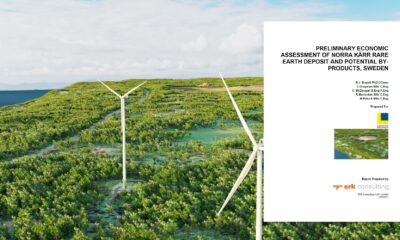
 Nyheter2 veckor sedan
Nyheter2 veckor sedanLeading Edge Materials är på rätt plats i rätt tid
-
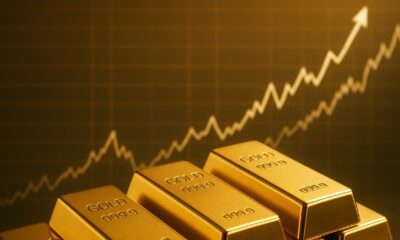
 Nyheter2 veckor sedan
Nyheter2 veckor sedanNytt prisrekord, guld stiger över 4000 USD
-

 Nyheter3 veckor sedan
Nyheter3 veckor sedanEtt samtal om guld, olja, koppar och stål


